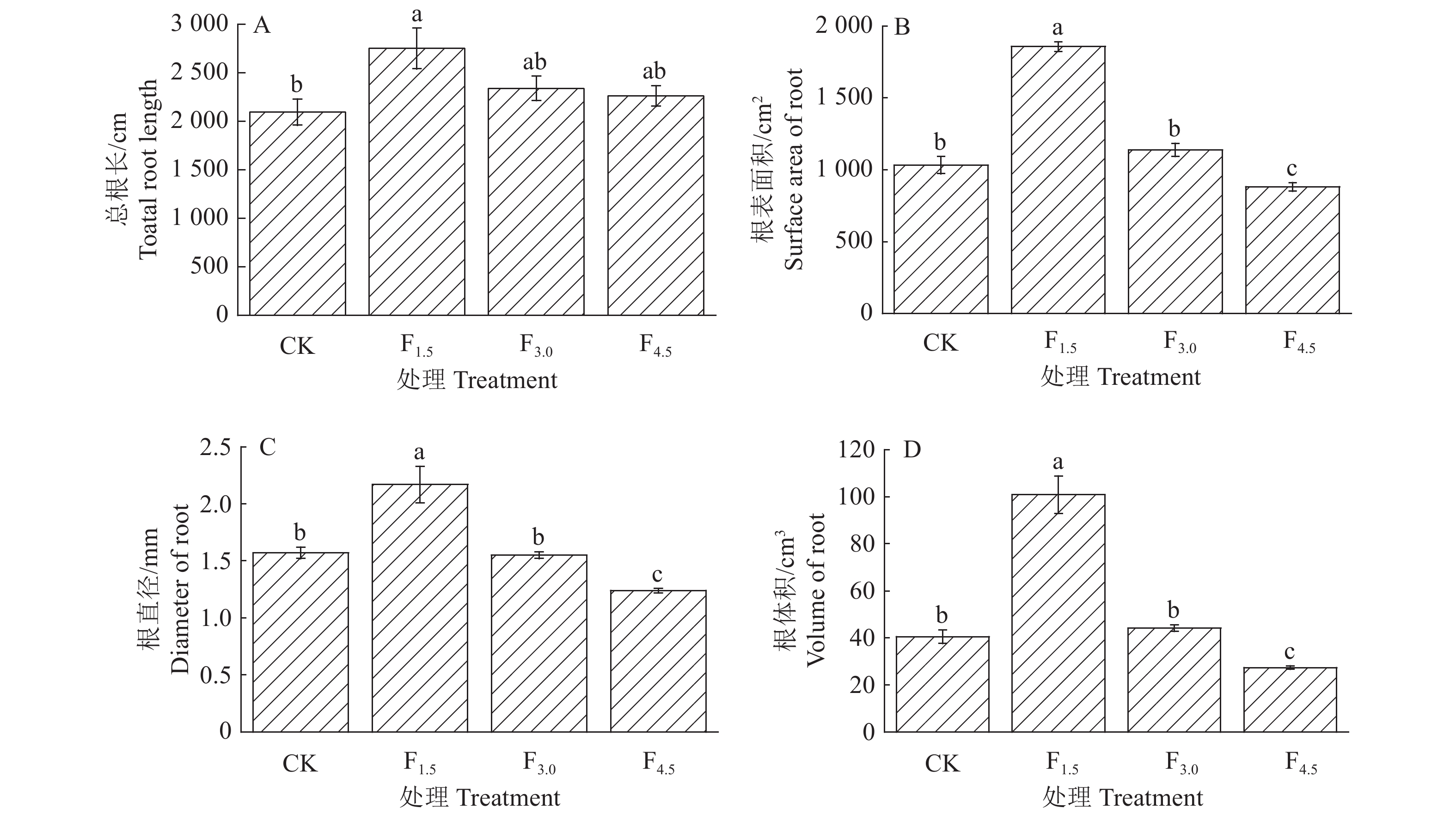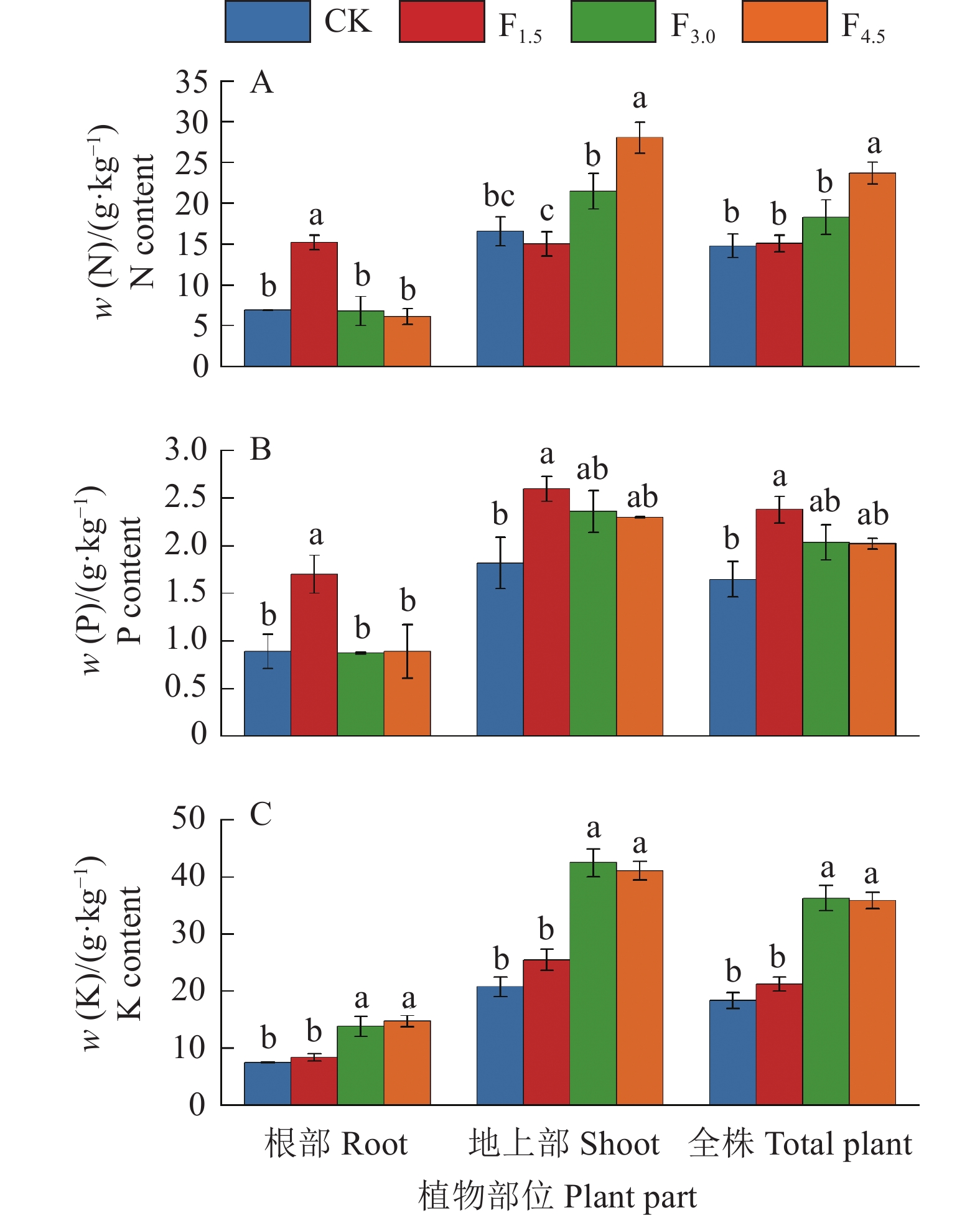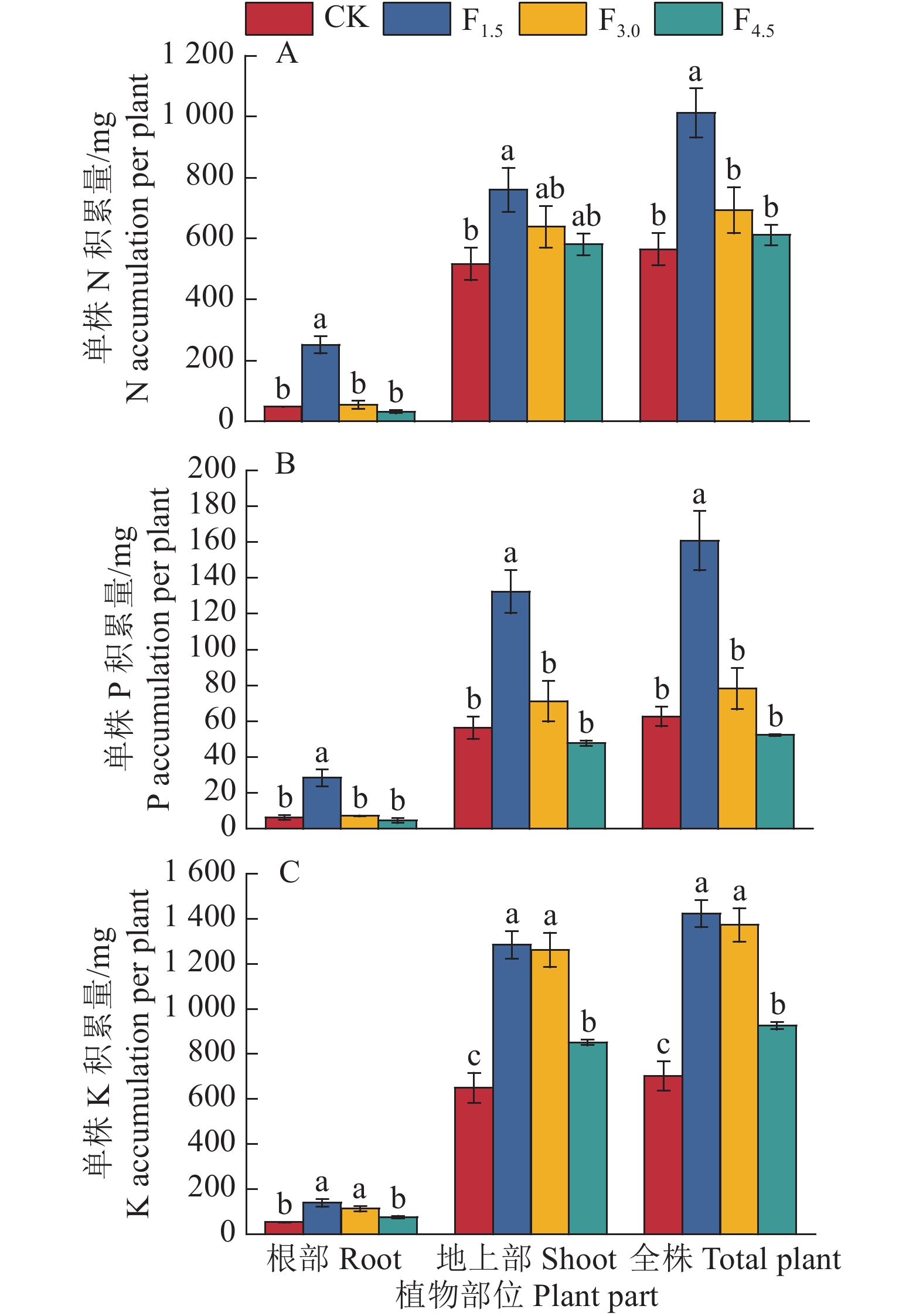Effects of litter biochar addition on sludge adaptability and heavy metal uptake of Ruellia simplex
-
摘要:目的
探究凋落物生物炭不同添加量对种植在污泥+土壤混合基质中的翠芦莉Ruellia simplex生长及重金属吸收累积的影响,以期为城市污泥和园林废弃物资源化利用提供参考依据。
方法通过盆栽试验,分析添加0、1.5%、3.0%和4.5%凋落物生物炭[占基质的质量分数(w),分别记为CK、F1.5、F3.0和F4.5]对翠芦莉生长、根系形态和生理以及养分和重金属吸收累积的影响。
结果与CK相比,F1.5处理显著增加翠芦莉株高、根系生物量、地上部生物量及全株生物量。植株生物量随w增加呈逐渐下降趋势,F4.5处理翠芦莉生物量显著低于CK,表现出“低促高抑”的特点。翠芦莉总根长、根表面积、平均直径、根体积在F1.5处理中达到最大,且均随w增加而逐渐减小。各处理中,F1.5处理根系可溶性蛋白和丙二醛(MDA)含量均最低,超氧化物歧化酶(SOD)活性最大;翠芦莉根系SOD活性随w增加呈下降趋势,但可溶性蛋白和MDA含量的变化趋势相反。与CK相比,各处理均不同程度提高了翠芦莉地上部及根部对N、P、K的吸收,不同程度降低了翠芦莉植株Cd、Cu含量,提高了Pb、Ni含量,N、P、K、Cd、Cu、Pb累积量均随w增加呈下降趋势;F1.5处理的翠芦莉植株N、P、K、Cd、Cu、Pb、Ni累积量均显著大于CK。
结论添加w为1.5%的凋落物生物炭可以显著促进翠芦莉生长和Pb、Cu、Cd、Ni的吸收累积,过量添加会抑制植物生长并影响其对基质中重金属的吸收效果,在实际应用中应合理控制生物炭的施用量。
Abstract:ObjectiveTo explore the effects of different addition amounts of litter biochar on growth, heavy metal absorption and accumulation of Ruellia simplex planted in the sludge + soil mixed matrix, and provide a reference for the resource utilization of municipal sludge and garden waste.
MethodA pot experiment was conducted to analyze the effects of adding 0 (CK), 1.5% (F1.5), 3.0% (F3.0) and 4.5% (F4.5) of litter biochar on growth, root morphology, physiology, nutrient and heavy metal uptake and accumulation of Ruellia simplex.
ResultCompared with CK, F1.5 significantly increased plant height, root biomass, shoot biomass and whole plant biomass. The plant biomass decreased gradually with the increase of biochar addition. The biomass of F4.5 was significantly lower than that of CK, showing the characteristic of “low promotion and high inhibition”. Total root length, root surface area, average diameter and root volume of Ruellia simplex reached the maximum in F1.5 treatment, and all of them gradually decreased with the increase of biochar addition. Among all treatments, the contents of soluble protein and malondialdehyde (MDA) in roots of F1.5 were the lowest, and the activity of superoxide dismutase (SOD) was the highest. The SOD activity of roots showed a downward trend with the increase of biochar addition, while the change trends of soluble protein and MDA contents were opposite. Compared with CK, all treatments increased the uptakes of N, P and K of R. simplex shoots and roots to different degrees, reduced the contents of Cd and Cu in R. simplex plant to different degrees, and increased the contents of Pb and Ni. The accumulative amounts of N, P, K, Cd, Cu, and Pb in R. simplex plant showed a downward trend with the increase of biochar addition, and the accumulative amounts of N, P, K, Cd, Cu, Pb and Ni of F1.5 were significantly higher than those of CK.
ConclusionThe addition of 1.5% litter biochar significantly promoted R. simplex growth, absorption and accumulation of Pb, Cu, Cd and Ni, but excessive addition would inhibit plant growth and affect the repair effect of substrate. Therefore, the applied amount of biochar should be controlled reasonably in the practical application process.
-
Keywords:
- Biochar /
- Applied amount /
- Ruellia simplex /
- Plant growth /
- Heavy metal absorption /
- Soil remediation
-
-
图 3 凋落物生物炭添加量对翠芦莉养分含量的影响
各图中相同植物部位柱子上方不同小写字母表示处理间差异显著(P<0.05,Duncan’s 法)
Figure 3. Effect of litter biochar addition on the nutrient content of Ruellia simplex
Different lowercase letters on bars of the same plant part in each figure indicated significant differences among treatments (P<0.05, Duncan’s test)
图 4 凋落物生物炭添加量对翠芦莉单株养分积累量的影响
各图中相同植物部位柱子上方不同小写字母表示处理间差异显著(P<0.05,Duncan’s 法)
Figure 4. Effect of litter biochar addition on the nutrient accumulation per plant of Ruellia simplex
Different lowercase letters on bars of the same plant part in each figure indicated significant differences among treatments (P<0.05, Duncan’s test)
表 1 供试基质的基本性质
Table 1 Basic properties of experimental materials
材料
MeterialpH w/(g·kg−1) w/(mg·kg−1) 有机质
Organic matter全氮
Total N全磷
Total P全钾
Total K碱解氮
Available N速效磷
Available P速效钾
Available KCu Pb Cd Ni 土壤 Soil 5.77 15.41 0.70 0.38 2.71 26.83 15.27 65.23 17.31 29.56 0.18 10.10 污泥
Sewage sludge7.52 96.54 7.35 4.81 6.43 428.50 611.08 413.27 423.66 48.51 19.88 47.96 表 2 凋落物生物炭添加量对翠芦莉生长的影响1)
Table 2 Effect of litter biochar application on the growth of Ruellia simplex
处理
Treatment株高/cm
Plant height生物量/g Biomass 根部
Root地上部
Above ground全株
Whole plantCK 106.67±1.86b 6.97±0.04b 31.22±1.39b 38.19±1.38b F1.5 124.00±4.51a 16.45±0.90a 50.72±2.35a 67.17±3.25a F3.0 104.67±2.33b 8.16±0.24b 29.80±1.99b 37.96±2.11b F4.5 98.00±3.79b 5.11±0.10c 20.73±0.64c 25.84±0.72c 1)表中数据为平均值±标准误,同列数据后不同小写字母表示处理间差异显著(n=3,P<0.05,Duncan’s法)
1)The data were mean±standard error, and the different lowercase letters after data of the same column indicated significant differences among treatments (n=3, P<0.05,Duncan’s test)表 3 凋落物生物炭添加量对翠芦莉植株不同部位重金属含量的影响1)
Table 3 Effect of litter biochar addition on heavy metal content in different organ of Ruellia simplex
w/(mg·kg−1) 植株部位 Plant part 处理 Treatment Cd Cu Pb Ni 根部 Root CK 7.21±0.34a 56.66±2.04a 2.46±0.44ab 1.58±0.05b F1.5 4.75±0.42b 21.71±0.78d 1.49±0.02b 1.66±0.08b F3.0 3.58±0.77b 42.17±2.31b 2.70±0.36a 3.95±1.08a F4.5 3.48±0.83b 30.27±0.83c 3.54±0.29a 5.57±0.49a 地上部 Shoot CK 0.62±0.13a 34.18±1.01a 0.60±0.21b 1.04±0.13c F1.5 0.64±0.04a 25.33±0.03b 2.36±0.29a 6.88±0.25b F3.0 0.51±0.05a 13.78±0.66c 1.86±0.08a 4.37±0.48b F4.5 0.66±0.09a 14.62±0.95c 1.78±0.14a 18.00±1.85a 全株 Total plant CK 1.83±0.20a 38.26±0.78a 0.95±0.17b 1.14±0.10c F1.5 1.65±0.10ab 24.44±0.22b 2.65±0.62a 5.61±0.18b F3.0 1.16±0.18b 19.94±1.27c 2.04±0.05a 4.25±0.48b F4.5 1.22±0.24ab 17.72±0.59c 2.13±0.14a 15.54±1.45a 1)表中数据为平均值±标准误,相同部位同列数据后不同小写字母表示处理间差异显著(n=3,P<0.05,Duncan’s法)
1)The data were mean ± standard error, and different lowercase letters after data of the same plant part on the same column indicated significant differences among treatments (n=3, P<0.05, Duncan’s test)表 4 凋落物生物炭添加量对翠芦莉单株不同部位重金属积累量的影响1)
Table 4 Effect of litter biochar addition on heavy metal accumulation of different organ per plant of Ruellia simplex
μg 植株部位 Plant part 处理 Treatment Cd Cu Pb Ni 根部 CK 50.19±2.34b 394.90±14.08a 17.17±3.17a 11.02±0.37b Root F1.5 77.42±3.57a 356.59±19.31ab 24.46±1.24a 27.27±2.24ab F3.0 29.18±6.22c 343.72±17.47b 21.85±2.22a 32.46±9.53a F4.5 17.82±4.35c 154.64±1.50c 18.17±1.82a 28.57±2.97a 地上部 CK 19.11±3.19b 1064.96±26.15b 19.39±7.71c 32.84±5.42c Shoot F1.5 32.61±2.36a 1284.56±58.40a 118.66±12.16a 348.21±9.23a F3.0 15.43±2.06b 407.97±7.45c 55.54±6.04b 130.48±18.18b F4.5 13.60±1.61b 304.05±27.27c 37.07±3.77bc 373.33±41.08a 全株 CK 69.36±5.50b 1459.86±39.96b 36.56±7.61c 43.86±5.05c Total plant F1.5 110.03±1.22a 1641.16±75.46a 178.24±44.55a 375.48±9.89a F3.0 44.61±8.20c 751.69±10.13c 77.39±5.11b 162.94±26.08b F4.5 31.42±5.76c 458.69±26.41d 55.24±5.13bc 401.90±40.26a 1) 表中数据为平均值±标准误,相同部位同列数据后不同小写字母表示处理间差异显著(n=3,P<0.05,Duncan’s法)
1) The data were mean±standard error, and different lowercase letters after data of the same plant part on the same column indicated significant differences among treatments (n=3, P<0.05, Duncan’s test) -
[1] YANG G, ZHANG G, WANG H. Current state of sludge production, management, treatment and disposal in China[J]. Water Research, 2015, 78: 60-73. doi: 10.1016/j.watres.2015.04.002
[2] HU Y, XU F, CHEN X, et al. Research progress on resource utilization of municipal sludge[J]. Meteorological and Environmental Research, 2019, 10(2): 64-66.
[3] 陈学民, 王惠, 伏小勇, 等. 赤子爱胜蚓处理污泥对其性质变化的影响[J]. 环境工程学报, 2010, 4(6): 1421-1425. [4] 余杰, 陈同斌, 高定, 等. 中国城市污泥土地利用关注的典型有机污染物[J]. 生态学杂志, 2011, 30(10): 2365-2369. [5] 赖明丽, 董晓全, 谢姗宴, 等. 污泥施用下园林植物生长适应性和重金属吸收[J]. 华南农业大学学报, 2022, 43(4): 47-57. [6] YUE Y, CUI L, LI Q M, et al. Efficiency of sewage sludge biochar in improving urban soil properties and promoting grass growth[J]. Chemosphere, 2017, 173: 551-556. doi: 10.1016/j.chemosphere.2017.01.096
[7] CORNELISSEN G, KUKULSKA Z, KALAITZIDIS S, et al. Relations between environmental black carbon sorption and geochemical sorbent characteristics[J]. Environmental Science & Technology, 2004, 38(13): 3632-3640.
[8] 周楫, 余亚伟, 蒋越, 等. 生物炭对污泥堆肥及其利用过程重金属有效态的影响[J]. 环境科学, 2019, 40(2): 987-993. [9] 卢晓蓉. 不同添加量凋落物及生物质炭对土壤有机碳矿化和微生物群落结构的影响[D]. 福州: 福建师范大学, 2019. [10] SARMAH M, BORGOHAIN A, GOGOI B B, et al. Insights into the effects of tea pruning litter biochar on major micronutrients (Cu, Mn, and Zn) pathway from soil to tea plant: An environmental armour[J]. Journal of Hazardous Materials, 2023, 442(129970): 1-16.
[11] OLADOYE P O, OLOWE O M, ASEMOLOYE M D. Phytoremediation technology and food security impacts of heavy metal contaminated soils: A review of literature[J]. Chemosphere, 2022, 288: 132555. doi: 10.1016/j.chemosphere.2021.132555
[12] 王淑民, 陈能海, 刘向国, 等. 粉煤灰钝化污泥对园林黄壤改良的效果[J]. 福建农业学报, 2018, 33(10): 1097-1103. [13] 鲍士旦. 土壤农化分析[M]. 北京: 中国农业出版社, 2000. [14] AGBNA G H D, SHE D L, LIU Z P, et al. Effects of deficit irrigation and biochar addition on the growth, yield, and quality of tomato[J]. Scientia Horticulturae, 2017, 222: 90-101. doi: 10.1016/j.scienta.2017.05.004
[15] 袁金华, 徐仁扣. 稻壳制备的生物质炭对红壤和黄棕壤酸度的改良效果[J]. 生态与农村环境学报, 2010, 26(5): 472-476. [16] 朱自洋, 段文焱, 陈芳媛, 等. 干旱土壤中生物炭对黑麦草生长的促进机制[J]. 水土保持学报, 2022, 36(1): 352-359. [17] KOCSIS T, KOTROCZÓ Z, KARDOS L, et al. Optimization of increasing biochar doses with soil-plant-microbial functioning and nutrient uptake of maize[J]. Environmental Technology & Innovation, 2020, 20(101191): 1-9.
[18] 周劲松, 闫平, 张伟明, 等. 生物炭对东北冷凉区水稻秧苗根系形态建成与解剖结构的影响[J]. 作物学报, 2017, 43(1): 72-81. [19] 惠锦卓, 张爱平, 刘汝亮, 等. 添加生物炭对灌淤土土壤养分含量和氮素淋失的影响[J]. 中国农业气象, 2014, 35(2): 156-161. [20] 孙海妮, 王仕稳, 李雨霖, 等. 生物炭施用量对冬小麦产量及水分利用效率的影响研究[J]. 干旱地区农业研究, 2018, 36(6): 159-167. [21] MORALES M M, COMERFORD N, GUERRINI I A, et al. Sorption and desorption of phosphate on biochar and biochar-soil mixtures[J]. Soil Use & Management, 2013, 29(3): 306-314.
[22] 赵殿峰, 徐静, 罗璇, 等. 生物炭对土壤养分、烤烟生长以及烟叶化学成分的影响[J]. 西北农业学报, 2014, 23(3): 85-92. [23] PURAKAYASTHA T J, BERA T, BHADURI D, et al. A review on biochar modulated soil condition improvements and nutrient dynamics concerning crop yields: Pathways to climate change mitigation and global food security[J]. Chemosphere, 2019, 227: 345-365. doi: 10.1016/j.chemosphere.2019.03.170
[24] JABBOROVA D, MA H, BELLINGRATH-KIMURA S D, et al. Impacts of biochar on basil (Ocimum basilicum) growth, root morphological traits, plant biochemical and physiological properties and soil enzymatic activities[J]. Scientia Horticulturae, 2021, 290(110518): 1-7. doi: 10.1016/j.scienta.2021.110518
[25] 唐光木, 侯艳艳, 潘金龙, 等. 棉杆生物炭对棉花根系特性及生理代谢的影响[J]. 西北农业学报, 2022, 31(3): 370-378. [26] 刘悦, 黎子涵, 邹博, 等. 生物炭影响作物生长及其与化肥混施的增效机制研究进展[J]. 应用生态学报, 2017, 28(3): 1030-1038. [27] 许樊蓉, 唐盛兰, 吴文, 等. 生物炭添加对娜塔栎容器苗生长和营养状况的影响[J]. 中南林业科技大学学报, 2022(7): 76-84. [28] 朱奕豪, 朱彦霖, 曹兴, 等. 生物炭对百合生理特性的影响[J]. 北方园艺, 2017(7): 92-98. [29] 李阳, 黄梅, 沈飞, 等. 生物炭对小麦种子萌发与幼苗生长的植物毒理效应[J]. 生态毒理学报, 2017, 12(1): 234-242. [30] 任怀新, 王冬梅, 王慧, 等. 生物炭对盐碱胁迫下黑麦草和紫花苜蓿光合及抗氧化特征的影响[J]. 农业工程学报, 2021, 37(17): 116-123. [31] WU D, PENG W, BAO L, et al. Biochar alleviating heavy metals phytotoxicity in sludge-amended soil varies with plant adaptability[J]. Environmental Research, 2022, 215(114248): 1-10. doi: 10.1016/j.envres.2022.114248
[32] 董盼盼, 张振明, 张明祥. 生物炭−植物联合修复对土壤重金属Pb、Cd分布效应[J]. 环境科学学报, 2022, 42(1): 280-286. [33] 王军, 刘程, 金鹏, 等. 污泥基生物炭对黑麦草生长特性及重金属累积的影响[J]. 安徽农业科学, 2022, 50(15): 79-82. doi: 10.3969/j.issn.0517-6611.2022.15.021 [34] NISSIM W G, PALM E, MANCUSO S, et al. Trace element phytoextraction from contaminated soil: A case study under Mediterranean climate[J]. Environmental Science & Pollution Research, 2018, 25(9): 9114-9131.




 下载:
下载:



